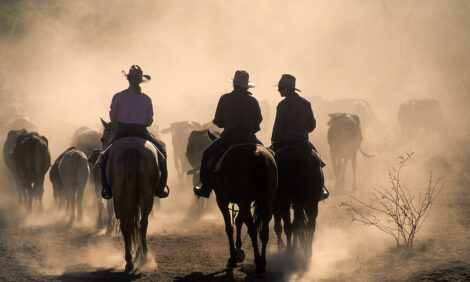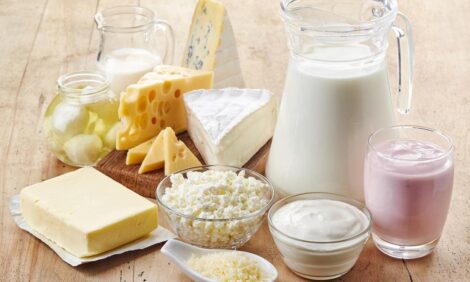



Market Cow and Bull Management and Marketing
Surveys of Mississippi cow-calf operations indicate that mature cows and bulls make up 85 per cent and 89 per cent of the cattle in breeding herds on operations with fewer than 100 head and greater than 250 head, respectively, says Jane A. Parish, Justin D. Rhinehart and John D. Anderson. This feature was published by the Mississippi State University Extension Service.
Market Cows and Bulls
Returns from sales of market cows and bulls comprise a significant portion of a beef cattle operation’s income.
The significance of market cow and bull revenue often is overlooked. The 1999 National Market Cow and Bull Quality Audit reported that returns from the sale of market cows and bulls accounted for about 16 percent of the total income of the average cow-calf operation. Market cow and bull sales generally represent between 10 and 30 percent of the sales receipts from a cow-calf operation. Therefore, optimizing the net return on market cow and bull sales can have a major impact on the overall profitability of the enterprise. In fact, the proceeds from the sale of market cows and bulls can make the difference in whether or not a cow-calf operation is profitable.
Additionally, market cows and bulls are an important food source. Market cows and bulls may be served to beef consumers within a week of leaving the ranch of origin. Traditionally, market cows and bulls were referred to as cull cattle and considered a byproduct of cow-calf operations. However, as the beef produced from cows and bulls is an increasingly important item in U.S. food retailer offerings, producers must view these animals as an important food and revenue source instead of viewing them as culls. Beef from market cows and bulls is not only used in hamburger but also in a wide variety of value-added food items including roasts, steaks, and strips.
Factors Influencing Cow and Bull Removal from the Herd
Deciding which cattle to remove and which to keep in the breeding herd impacts future herd performance and profitability. One challenge in choosing cattle to market is identifying those that are making the operation money and those that are costing the operation money. There are many factors to consider when choosing which cattle to market. The percent of cows sold by reason as reported in the National Animal Health Monitoring System’s Beef ’97 study appears in Figure 1. Age or bad teeth was the most commonly declared reason for marketing cows followed by pregnancy status. Larger operations, in terms of herd size, were less likely to market cows for economic reasons than smaller operations.
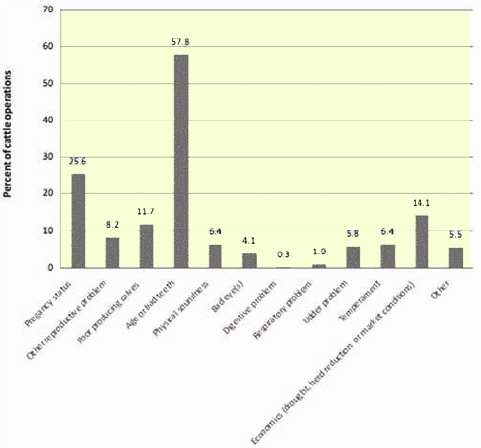
Pregnancy Status
One of the greatest determinants of profitability in a cow-calf operation is reproductive rate. Open (nonpregnant) cows are a drain on resources. They consume feed, forage, and other resources without producing a marketable calf to contribute to expense payments. Cows that are open at the end of the breeding season should be at the top of the marketing list. Cows that calve outside of a controlled calving season are also candidates to be sold, particularly when feed and forage supplies are running short. Late calving cows should be scrutinized as well, because they have less opportunity to breed back to stay within a controlled breeding season.
Poor Performance
Poor calf performance is usually the result of inferior genetics, poor dam milk production, calf illness, or a combination of these factors. Cows passing on inferior genetics to their calves for economically important performance traits and cows with unacceptably low milk production should be considered for removal from the herd. If poor calf performance is due in large part to calf illness and not associated with the dam, then the dam may still have a productive future. While genetic improvement is largely dependent on sire selection, the dam contributes half of the genetics to the calf. For seedstock producers, removing cows with expected progeny difference (EPD) values that do not compare favorably with breed or herd averages for economically important traits contributes to herd genetic improvement. Many breed associations publish breed averages and percentile ranking tables for EPDs of active dams.
Age
The productive lifetime of a beef cow is variable. As long as teeth, udders, feet, and legs are sound, many older cows are often still able to perform well. Breed composition and production environment can play a role in longevity. Research on Brahman-influenced cows indicated that there was consistent rebreeding performance through about 8 years of age and a decline in reproductive performance after 10 years of age. An even steeper drop in reproductive performance occurred in cows beyond 12 years of age. These are averages and do not mean that individual cows will be less productive through an advanced age. Ideally, cows should be removed from the herd for advancing age prior to a sharp decline in reproductive or maternal performance. In addition, with an emphasis on herd genetic improvement, younger beef females are often genetically superior to older cows.
Mouth
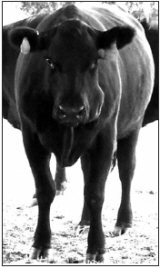
Teeth wear with normal use over time. Gritty feeds and forages accelerate tooth wear. Soil type can affect how long teeth remain sound, with sandy soils typically advancing tooth wear. Cows can eventually wear their teeth down to a stage where grazing is severely impacted. This results in poor body condition despite adequate available nutrients. “Smooth-mouthed” cows have teeth worn down to the gums. Cows may also lose teeth at any age from being knocked out by blunt force or from gum disease or infection resulting in a “broken-mouthed” condition. These cattle may dribble feed and have a hard time consuming adequate quantities of feed or forage. Lumpy jaw (Figure 2) is another condition of the mouth that can negatively impact grazing ability. While less than 1 percent of cattle harvested as part of the 2007 National Market Cow and Bull Beef Quality Audit had lumpy jaw, 17 percent had eight extremely worn adult incisor teeth and were classified as gummers. Annual inspection of the teeth and mouths during routine cattle working is recommended.
Udder
Udder soundness affects milk production, milk consumption, and ultimately calf weaning weights. Proper udder attachment in a beef female is important for a long, efficient, productive life. A sound udder should be firmly attached with a strong, level floor and four properly formed teats proportional to body size. Weak udder suspension results in pendulous udders that are difficult for a sucking calf to nurse. Balloon or funnelshaped teats are also difficult to nurse and may decrease calf milk consumption and weaning weight. Balloon teats are also sometimes an indication of a past case of mastitis (a bacterial infection of the mammary tissue). The udder should be healthy and free of mastitis in all four quarters for good milk production.
Structural Soundness
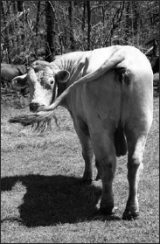
Structural soundness is important for functionality. Structural problems subject the joints to excessive wear and stress that can eventually hamper mobility. Cows that have difficulty moving around the pasture may be less active grazers. Cows need to be sound enough for effective grazing and successful pasture breeding. Condition and performance of structurally unsound or crippled cattle often diminishes. Obvious structural defects can decrease the market appeal of an animal as well.
Lameness is a major reason for culling cattle. Lameness leads to decreased performance, decreased reproductive efficiency, weight loss, and increased treatment costs. Many conditions can cause lameness in cattle including foot rot, laminitis, joint injury (Figure 3), and fescue toxicosis. Herd sires affected by lameness may be ineffective or less aggressive breeders and should be marketed for slaughter in a timely manner. Arthritic joints are removed from beef carcasses. In the 2007 audit, 95 percent of beef cow carcasses and 91 percent of beef bull carcasses had no arthritic joints removed. When deciding to market cattle for lameness, make sure that cattle are not too compromised for transport. Non-ambulatory (downer) cattle are not acceptable in the beef industry. Significant improvement in reducing numbers of downer cattle has occurred since the 1999 audit.
Reproductive Soundness
Cases of prolapse may necessitate terminal marketing. A vaginal prolapse occurs when vaginal tissue protrudes through the vulva where it is exposed to the outside environment, potential injury, and diseasecausing agents. Uterine prolapse is a condition in which the uterus is pulled through the birth canal with the calf or afterbirth. Vaginal prolapse typically occurs during late gestation as calving approaches, while uterine prolapse usually occurs at or shortly after calving. Because vaginal prolapses (unlike uterine prolapses) are likely to recur and are known to have a genetic component, cows suffering from this condition should be added to the marketing list.
A bull should be marketed if he fails consecutive breeding soundness exams (BSE) or if a veterinarian deems him a “non-breeder.” Some bull reproductive tract problems can be corrected if detected well in advance of the breeding season. Problems to be aware of include persistent frenulum (a thin piece of tissue that connects the penis to the prepuce), penile hair rings, torn or injured prepuce, deviation of the penis, and penile warts. Most injuries that cause swelling or laceration can be corrected by rest from sexual activity to allow healing. A persistent frenulum can be torn or cut to allow extension of the penis, warts can be manually removed, and some deviations can be surgically corrected. These issues can be detected in a BSE, and bulls with these problems should be candidates for market if the problems cannot be resolved. The most important thing to remember is that a BSE is not a one-time procedure. It should be performed at least once a year or before each breeding season.
Health Problems
Cancer eye can impair a cow’s ability to raise her next calf. Removal from the herd is often the best option once an affected cow has weaned her calf. The National Market Cow and Bull Beef Quality Audits show that cancer eye incidence has trended downward from a rate of 8.5 percent in 1994 to 3 percent in 2007.
Another health issue that may determine if a cow or bull should be removed from the herd is Johne’s disease. Johne’s disease is a chronic, incurable, contagious infection of the intestinal tract. Calves usually become infected when they nurse udders that are contaminated with infected fecal material or when they are housed in contaminated pens or pastures. Johne’s disease causes severe, explosive diarrhea and weight loss in adult cattle leading to enormous production losses in infected herds. Since there is not an effective treatment or cure for Johne’s disease, the best way to keep infected cows or bulls from spreading it to others in the herd is to remove them from the herd. Blood or fecal culture tests may be performed to identify infected cattle.
Disposition
Bad disposition or “high-headed” cattle are dangerous and should be prime candidates for removal from the herd. Terminal marketing for unacceptable disposition reduces the risk of injury to both cattle and people. Mississippi research results indicate that excitable calves often sacrifice growth performance and Quality Grade compared to calmer calves. Studies have also shown that excitable cattle are more likely to produce dark cutter carcasses, which are subject to severe price discounts. Because calves inherit a genetic component of temperament and also pick up habits from their dams during the suckling phase, bad attitudes can be propagated within the herd without selection pressure for acceptable disposition.
Managing Market Cows and Bulls
Production Implications
Usually, non-pregnant cows are identified at pregnancy diagnosis, sorted directly into a separate pen, loaded that day (or as soon as the calves are weaned), and then transported to a livestock marketing facility. Often, scheduling the herd pregnancy check even revolves around days when the local auction has a sale so that the non-pregnant females can be immediately liquidated. As a matter of production management, it is critical to remove non-producers from the herd.
Transportation and Handling
In the 2007 National Market Cow and Bull Beef Quality Audit, cattle surveyed were trucked an average of nine hours and 409 miles. Less than 1 percent of the audited cattle traveled more than 28 hours. Compared to previous audits, cattle that were injured and could not walk were virtually eliminated. In addition, all truck and trailer loads met American Meat Institute guidelines for spacing.
Despite these improvements, the cattle industry still needs to address several cattle transportation- and handling-related issues when shipping market cows and bulls. First, unnecessary use of electric prods and aggressive use of other driving aids in cattle handling is a problem that continues to need improvement. Not overcrowding cattle during movement, slowly moving cattle to and from pens, using properly designed and well-maintained cattle handling facilities, and improving cattle transportation is essential throughout the beef cattle industry. Beef cattle producers should familiarize themselves with the guidelines outlined in the Master Cattle Transporter program. Producers should work with individuals transporting their market cows and bulls to make sure that they employ cattle management and handling practices consistent with the Master Cattle Transporter program recommendations.
When loading cattle, separate animals by gender to reduce the occurrence of injury or bruising. The 2007 audit found that 44 percent of market cow and bull loads arriving at harvest plants were multi-gender. Of these mixed-gender loads, 73 percent were not divided on the trailer by gender. Even though the 2007 audit found fewer carcasses with bruises than the earlier audits, only 47 percent of bulls and 37 percent of cows exhibited no bruises at harvest. The round was the most frequent site of bruising in market cow and bull carcasses. This corresponds to the hindquarters on the live animal and suggests that improvements in cattle handling could decrease bruising rates in this location. Reducing bruising starts with management changes on the ranch and extends through transportation and at the harvest facility.
Finally, while unloading, give attention to methods that reduce cattle slipping by improving footing. Twenty-seven percent of beef cattle loads had more than 3 percent of the cattle slip during unloading. Cattle industry participants should learn and implement low-stress cattle handling methods to improve handling on the ranch and to reduce the incidence of slipping and bruising during and after transport.
Managing To Minimize Cattle Defects
Beef cattle producers can prevent many common quality defects in market cows and bulls. Bruising necessitates carcass trimming and results in less saleable product. The beef cattle industry has virtually eliminated carcasses with buckshot or grubs. In addition, 94 percent of carcasses in the 2007 audit showed no signs of injection site lesions suggesting that many producers follow recommended Beef Quality Assurance practices. Fewer cattle had brands than in 1999. Brands lower hide values, particularly when located over the ribs.
Ten percent of beef cows in the 2007 audit were pregnant at harvest, an improvement over previous audits. Producers can further reduce this figure by removing bull exposure for cows headed to terminal markets. While local market premiums for pregnant beef females may exist, cows that are at the end of their productive lives or affected with health problems should remain non-pregnant and marketed for harvest.
Despite many recent improvements in minimizing defects in market cows and bulls, there are some concerns that require added attention. Liver condemnations are on the rise, with nearly half (45 percent) of livers in market cow and bull carcasses being condemned. Livers contribute to overall carcass value, so progress in liver acceptance rates will improve average carcass values. Liver abscesses can be minimized through proper diet formulation. Liver condemnations as a result of liver flukes can be lessened by implementation of proper internal parasite control programs.
Genetic Improvements
Combining genetic improvements and good animal management practices results in better market cow and bull products. The 2007 National Market Cow and Bull Beef Quality Audit found that 21 percent of all cattle audited were inadequately muscled. There were fewer light-muscled beef cows in 2007 as compared to the 1999 audit. The number of beef cows with a muscle score of 1 (Table 1) was much lower in 2007 (14 percent) than in 1999 (44 percent). Improved individual animal selection and crossbreeding programs can address concerns with inadequate muscling in market cows. In addition to genetic improvement, muscle can be added to thin cattle with added nutrition. More cattle were polled (without horns) in the 2007 audit than in 1999. Fewer horns, as a result of genetic selection for polled cattle and use of dehorning practices, reduced the likelihood of bruising. Horn removal can help reduce head condemnations at harvest. Selection against wild or temperamental cattle is another key issue to address through genetic improvement efforts.
| Table 1. Slaughter Cow Muscle Scores | |
| Muscle Score Description | Muscle Score Number |
|---|---|
| Thin - | 1 |
| Thin | 2 |
| Thin + | 3 |
| Average - | 4 |
| Average | 5 |
| Average + | 6 |
| Thick - | 7 |
| Thick | 8 |
| Thick + | 9 |
| Source: USDA, 2008. Adapted from Slaughter Cow Guidelines. | |
Market Cow and Bull Quality Assurance
The 2007 National Market Cow and Bull Beef Quality Audit revealed that cattle producers improved herd management techniques, animal welfare and handling, hide damage, injection-site location, and bruises in market cows and bulls from 1999 to 2007. Specific points of improvement were identified in the 2007 audit to achieve the goals of recognizing and optimizing the value of market cows and bulls on individual ranches and enhancing consumer satisfaction of the resulting beef products from these cattle. The top quality challenges identified in the 2007 audit included: 1) food safety, 2) animal welfare/handling, 3) poor condition/ nutrition, 4) antibiotic residues, 5) bruises, 6) hide damage, 7) lameness/soundness, 8) condemnation rates/downers, and 9) injection-site prevalence.
Timely Marketing
Cattle should be marketed before becoming too thin or too lame for transport. Incidence of lameness in market bulls and cows received at harvest points fell from 1999 to 2007. In the 2007 audit, 16 percent of market cows and 31 percent of market bulls showed signs of lameness, down from 27 percent and 36 percent, respectively, in 1999. The 2007 audit showed significant improvement in the reduction of downer cattle.
Beef cattle producers must recognize the importance of continuously monitoring herd health and ensuring that cows and bulls are marketed before they become too compromised to ship to market and, ultimately, harvest facilities. Prompt intervention in herd health problems is critical. Consider marketing cattle showing structural or disease problems rather than holding on to them attempting to get more calves. In advanced cases of cattle disease or injury, producers should consider euthanasia as the best option for removing these cattle from the herd.
In instances where cattle body condition scores (BCS) fall below 3 (on a scale of 1 to 9), cattle may not be sound enough for transport. Reconditioning programs where market cows and bulls are placed on nutritional regimens to gain muscle and fat can result in both sounder animals for shipping and profitable returns for the investment by the cattle producer.
Consumer Concerns
Public perception of the beef industry necessitates that beef cattle producers actively address beef consumer concerns about food safety, antibiotic use, and animal care and welfare. Adhering to the Quality Assurance Marketing Code of Ethics is an important step beef cattle producers should take to respond to consumer concerns.
Quality Assurance Marketing Code of Ethics
I will only participate in marketing cattle that—
- do not pose a known public health threat.
- have cleared proper withdrawal times.
- do not have a terminal condition (including advanced lymphosarcoma, septicemia, etc.).
- are not disabled.
- are not severely emaciated.
- do not have uterine/vaginal prolapses with visible fetal membrane.
- do not have advanced eye lesions.
- do not have advanced lumpy jaw.
Furthermore, I will—
- do everything possible to humanely gather, handle, and transport cattle in accordance with accepted animal husbandry practices.
Finally, I will—
- humanely euthanize cattle when necessary to prevent suffering and to protect public health.
When shipped for harvest, market cows and bulls must be free of chemical and physical hazards. Producers should remove any needles that break off when administering animal health products. Violative residues from applications of drugs, insecticides, or wormers must be avoided. Once decisions are finalized on which animals to market, animal health product withdrawal times must be cleared prior to marketing. It may be much easier to make marketing decisions early and then to schedule animal health product applications accordingly. Recommended guidelines for animal health product administration must be followed including location and method of administration, dosage, and specified withdrawal time.
Maintaining good record-keeping systems and improved animal identification is important to verify Best Management Practices and reduce producer liability for issues resulting after harvest. Documentation of animal health product use is critical to this effort.
Marketing Strategies
for Market Cows and Bulls
Appropriate times to remove cows and bulls from the herd depend on the reasons for removal from the herd. In cases where cows have developed severe health problems, removal from the herd may need to be immediate. In situations where cows are being marketed for low performance or other less urgent factors, it often makes sense to wait until after nursing calves are weaned. If market conditions are such that even cows weaning low-performing calves are generating a profit, it may be cost-effective to hold onto these cows in the near term and then market them before they become unprofitable. Production conditions can also influence the best time to remove cows from the herd. During drought or other conditions where forage and feed resources are limited, culling deeper into the herd is often appropriate.
A recent survey of Mississippi cow-calf producers asked what most influenced their decisions to market calves. A majority of those who responded cited their calves reaching a set target weight or the market reaching a certain price as the major deciding factor. However, this concept does not appear to carry over to marketing market cows and bulls. The major factors that should be considered when deciding to hold market cows and bulls are current and expected market cow and bull values and nutrition program costs.
Market Cow and Bull Price Classes
The U.S. Department of Agriculture publishes a weekly market cow and bull price report titled “Southern Direct Slaughter Cow and Bull Carcass Report.” It can be accessed at www.ams.usda.gov/mnreports/mg_ls134.txt. This report lists market cow carcass prices for the following categories: Lean (90 percent lean and previously reported as Cutter/Canner), Boners (85 percent lean), and Breakers (75 percent lean). Boners and Breakers were formerly called Utility grade cattle. Within these classes, prices are reported for various weight ranges. Market bull carcass prices are listed for 92 percent lean carcasses and include a weight class that incorporates low yielding and fat bulls. Cow grades are indicated by BCS with Lean typically having a BCS 1 to 3, Boners a 5 to 9, and breakers a 6 to 9.
Premiums often exist for market cows and bulls meeting specifications for white fat markets. The USDA recognizes carcasses from these cattle as “Premium White,” a term for two meat grades that recognize and reward white fat instead of the more common yellow fat. Premium White replaces the Commercial grade. These grades identify carcasses from mature cattle with a white fat covering and more marbling. Certain meat retailers seek out Premium White meat cuts and are willing to pay more for this meat. Grain feeding is needed to move these cattle from yellow fat associated with forage-based production systems to white fat and associated premium marketing opportunities. The 2007 audit revealed that more market cows had desirable fat color scores of 1 and 2 (whiter color) than in 1999 or 1994.
Direct Marketing
Some beef cattle producers choose to send market cows and bulls directly to harvest points in a direct marketing arrangement. Many cattle harvest facilities will accept market cows and bulls delivered on-site without prior marketing arrangements. Producers who can assemble tractor trailer load lots of market cows and bulls may find direct marketing to be a desirable option. However, local marketing can be a more profitable option in many instances.
Local market cow and bull prices, transportation costs, limited locations for market cow and bull harvest in the southeastern United States, and market preferences of specific harvest plants must be considered when choosing whether or not to direct market to a harvest facility. The 2007 National Market Cow and Bull Beef Quality Audit reported a range of 60 to 1,050 miles that beef cattle were transported from ranches to harvest points. With a finite number of practical harvest locations for which to ship, it is important to recognize the characteristics of market cows and bulls desired by the individual harvest plants nearest in proximity to the ranch of origin.
Seasonal Price Trends
As with many other commodities, market cow prices display seasonal fluctuations that can provide a good estimate of the expected relative market value from month to month (Figure 4). These cattle price levels and seasonal trends should be taken into consideration in deciding when to market cows and bulls.
When cow and bull prices are trending upward, it is often advantageous to wait to market cows and bulls if the increasing values can cover added production expenses from holding these cattle on the ranch. It may also be advantageous to retain market cows and bulls until weight and body condition can be added. Unlike feeder cattle prices, market cow and bull prices typically increase on a per-pound basis with increasing cattle weights.
However, if market cow and bull prices are trending downward, then it may be advisable to market these cattle in a timely manner before more money is invested in animal maintenance, particularly if this investment will not likely be recovered. In Mississippi, market cow and bull prices typically peak in the spring months, begin to decline in July, and eventually reach the lowest point in November.
During major winter holidays, many local stockyards are closed, affecting the supply of market cows and bulls. This can elevate market prices for these classes of cattle during the winter holidays.
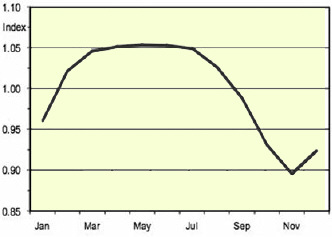
Given this type of seasonal fluctuation, a simple equation can be used to determine the profitability of holding cows over a defined period of time:
Net Returns = Sale Weight × Sale $ – ((Market Weight × Market $) + Cost of Gain + Death Loss + Marketing and Medicine)
In this equation, the “Sale Weight” is the expected weight of the cows when marketed and is calculated as the amount of weight the cows will be able to gain by the projected market date given feed and forage availability. “Sale $” is the expected value (per-weight basis) of the cows on the projected sale date. “Market Weight” is the current weight of the cows when the marketing decision is made and gives the starting point for projecting sale weight, while “Market $” refers to the value of the cows (on a per-weight basis) at the time of marketing. Cost of gain can be calculated by developing a diet, using feed and forage available at a reasonable cost, that will accomplish the projected sale weight by or before the projected sale date. A conservative estimate of death loss should be made based on previous experience for a given area or set of cows.
Using this simple equation should give an adequate prediction of whether a profit can be realized from holding market cows. This equation also can be used by stocker operators considering purchasing market cows or bulls during market lulls, adding value to them, and then selling them for a profit. To use this equation in determining whether or not to purchase cull cows or bulls, simply replace “Market Weight” and “Market $” with the purchase price.
An example scenario for a spring-calving herd would be that pregnancy check is performed sometime between July (about 45 days after bulls are removed) and September (when calves are weaned) to identify open cows. Along with open cows, lame, poor mouth, or poor producing cows are identified and added to the marketing list. If calves are weaned in September, the cow and bull market has already begun to decline from its peak in July and will not return to comparable levels until March or April. Therefore, if only considering market trends, it would be beneficial to winter these cows until the spring market rebound. However, there is a substantial cost associated with feeding cows through the winter months and, depending on available resources, it may cost more than the potential profit to hold these cows over. For example, market cows might weigh 1,050 pounds with a body condition score (BCS) 4 at weaning. If they can be fed to a BCS 6 over the winter, it will likely translate to a weight gain of 200 pounds. On a diet of fair quality hay supplemented at moderate rates with soybean hull pellets and corn gluten, this gain would cost approximately $218.
Example: Profit = 1,250 lbs × $0.4945 – ((1,050 × $0.43) + $218 + 2%Loss + $40) Profit = -$103.74 per cow
In this basic example, feeding market cows through the winter with relatively expensive feed sources is not profitable. However, one important factor that has not been considered in this scenario is that the value of these lean cows (85 to 90 percent lean) can be further improved if, after sufficient weight gain, their grade is improved and they are sold as 80 to 85 percent lean, high yield Boners. Traditionally in the southeast United States, this would translate into a $5 per cwt price improvement. In this case, wintering the market cow would still not be a profitable venture (- $42.49 per cow).
An effective way to change the equation to be more profitable is to reduce the “Cost of Gain.” This is where the southeast United States’ ability to use coolseason forages for grazing becomes very important.
Assuming a $0.45 per pound cost of gain for mature cows on annual ryegrass, the cost of adding 200 pounds to a 1,050-pound cow is $90. In the equation used above, this would translate into a profit of $85.51 per cow if they move into the more desirable grade, or $24.26 per cow if they remain in the 85 to 90 percent Lean grade. This would assume early annual ryegrass availability or use of tall fescue. However, stocker operators who are interested in purchasing market cows or bulls and adding value have the opportunity to wait until the lowest point of the market cow and bull price cycle (around November) when annual ryegrass or tall fescue should be plentiful. In this case, if cattle are bought at $39 per cwt and marketed in April or May after the cattle have reached the target weight of 1,250 pounds, the potential profit from the above equation would be approximately $127.51 for high yield Boners and $66.26 for 85 to 90 percent Lean.
As with most other agricultural enterprises, production volume is a deciding factor when considering whether to stocker market cows or bulls. The equation used in these examples does not account for labor or opportunity costs. For small cow-calf producers who might have just a few market cows and bulls and limited (high cost) feed resources, holding these cattle will most likely not be profitable. However, for large cowcalf producers or stocker operators who have the opportunity to limit cost of gain and realize smaller profit margins per animal on larger total numbers, stockering market cows or bulls can prove to be a lucrative endeavor.
Conclusions
Market cow and bull management and marketing strategies impact both calf quantity and quality and, when planned and implemented effectively, can greatly enhance the profitability of a cow-calf operation. Making informed decisions helps maintain a high level of herd performance. Even favorite cows and bulls should be subject to a systematic culling, management, and marketing process. The key message of the 1999 National Market Cow and Bull Quality Audit (listed below) remains very applicable to current beef cattle production efforts.
To promote value in market cows and bulls, producers should
- manage their cow herds to minimize quality shortcomings and defects
- monitor the health and condition of market cows and bulls, and
- market cows and bulls in a timely manner.
October 2008


